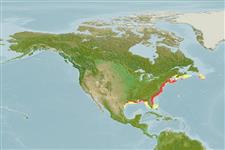Teleostei (teleosts) >
Eupercaria/misc (Various families in series Eupercaria) >
Sparidae (Porgies)
Etymology: Stenotomus: Greek, stenos = narrow + Greek, stoma = mouth (Ref. 45335).
More on author: Linnaeus.
Environment: milieu / climate zone / depth range / distribution range
Ecology
Marine; demersal; oceanodromous (Ref. 51243); depth range 15 - ? m (Ref. 4926). Subtropical; 46°N - 25°N
Western Atlantic: Nova Scotia in Canada to Florida in USA; rare south of North Carolina, USA.
Length at first maturity / Size / Weight / Age
Maturity: Lm 15.5 range ? - ? cm
Max length : 46.0 cm TL male/unsexed; (Ref. 7251); common length : 25.0 cm TL male/unsexed; (Ref. 9988); max. published weight: 2.1 kg (Ref. 40637)
Occurs usually in schools inshore in summer and offshore in winter. Feeds on amphipods, worms, sand dollars and young squid (Ref. 4926). Utilized fresh, smoked and frozen; eaten pan-fried, broiled and baked (Ref. 9988). Exported to Japan (Ref. 9988)
Robins, C.R. and G.C. Ray, 1986. A field guide to Atlantic coast fishes of North America. Houghton Mifflin Company, Boston, U.S.A. 354 p. (Ref. 7251)
IUCN Red List Status (Ref. 130435)
Threat to humans
Reports of ciguatera poisoning (Ref. 30911)
Human uses
Fisheries: commercial; gamefish: yes; aquarium: public aquariums
Tools
Special reports
Download XML
Internet sources
Estimates based on models
Preferred temperature (Ref.
123201): 9.4 - 24.6, mean 23.5 °C (based on 106 cells).
Phylogenetic diversity index (Ref.
82804): PD
50 = 0.7500 [Uniqueness, from 0.5 = low to 2.0 = high].
Bayesian length-weight: a=0.01738 (0.01048 - 0.02881), b=3.01 (2.87 - 3.15), in cm total length, based on LWR estimates for this species & (Sub)family-body (Ref.
93245).
Trophic level (Ref.
69278): 3.8 ±0.1 se; based on diet studies.
Resilience (Ref.
120179): Medium, minimum population doubling time 1.4 - 4.4 years (K=0.17-0.23; tmax=19).
Fishing Vulnerability (Ref.
59153): Moderate to high vulnerability (51 of 100).
Climate Vulnerability (Ref.
125649): Moderate vulnerability (40 of 100).
Nutrients (Ref.
124155): Calcium = 78.5 [35.6, 139.6] mg/100g; Iron = 1.03 [0.55, 2.10] mg/100g; Protein = 19.3 [18.2, 20.5] %; Omega3 = 0.332 [0.195, 0.556] g/100g; Selenium = 30.7 [14.6, 62.3] μg/100g; VitaminA = 7.68 [2.00, 29.30] μg/100g; Zinc = 0.578 [0.379, 0.855] mg/100g (wet weight);
